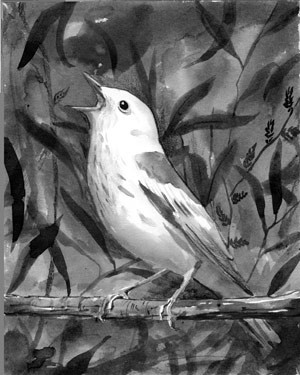
The yellow warbler is a tiny explosion of color, music and tenacity. Every spring these songbirds arrive from the tropics to our alder swamps, willow stands and wet thickets. The male glows neon yellow with blood-orange pinstripes and marble-black eyes. He perches in the open and sings a rich, piercing “Sweet-sweet-sweet, summer-summer sweet!” The female, a muted version of the male, often rewards us by building her nest at our eye level. In many respects, the yellow warbler is close to being the perfect songbird. It is also a shameless opportunist.
Like most migratory songbirds, yellow warblers come north each spring to do what songbirds do up here – make more songbirds. They methodically build nests of downy plant fiber and spider webs, copulate, lay and nurture eggs, and feast and feed their young with our abundant spring insects. Then they promptly leave. They’re leaving now, southbound, without regret, in what to some is an inconvenient truth about fall migration: It actually begins in summer.
Oh, sure, we’ll see and hear geese, thrushes, sparrows and hawks moving south in waves during apple cider season. But don’t be fooled. While we’re cursing zucchini, dozing in the hammock or watching the Red Sox, while we’re enjoying those ephemeral months we call summer in northern New England, plenty of birds are either long gone or close to leaving. In many species, the adults won’t even wait until their young are ready (fattened up) for migration. They will take off for Central or South America without the kids, the avian equivalent of the parents in the movie Home Alone.
Sandpipers are perhaps the obvious vanguard of “fall” migration. From their arctic breeding grounds, they begin moving south and showing up in July in Vermont’s Champlain Valley or on the New Hampshire seacoast. Now staging on the coast are such elegant, long-legged birds as willet, short-billed dowitcher and greater yellowlegs. Anyone who wants to see the best of the sandpipers moving through Vermont or New Hampshire had better not wait past August. But if you do miss the shorebird show, the hawks begin floating south in good numbers in September. Ducks and honking skeins of geese, the proverbial fall migrants, move through in October and November. And all the while, from July even into December for the most hearty, songbirds are leaving or passing through New England for warmer destinations.
The triggers for fall migration vary. Those ducks and geese leave when snow or freezing temperatures set up on their breeding and feeding grounds. Hawks float high on thermals of air rising from valleys and, when reaching sufficient elevation, break off to coast southbound, with hardly a flap, pushed along by the prevailing fall breeze from the north.
Many songbirds don’t necessarily leave to escape the cold. They need no external stimulus, no harsh conditions, to launch them into migration. They are genetically hard-wired to leave before the food runs out or the nights become chilly. Yellow warblers are a fine example. They are not necessarily leaving something uncomfortable, but perhaps responding to an urge to move on to something beneficial. For many, particularly those young birds having never made the trip, it is a migration of faith, a journey of instinct.
And make no mistake about it: Migration is no vacation. We tend to examine threats to migratory songbirds here on their breeding grounds (acid deposition, mercury poisoning, pesticides, habitat loss, invasive plant species and global climate disruption) and away in the tropics (all of the above plus deforestation). These are critical concerns. But only now are we looking at the risks birds encounter during the riskiest stage of their lives – migration. Once they leave us, migrants need habitat along their routes to rest and feed and refuel.
The poster bird for this may be the red knot, a sandpiper that breeds in the high arctic but winters as far south as Tierra del Fuego. To move north, birds flying along the Atlantic coast stop to feed on the newly laid eggs of horseshoe crabs. But increased harvests of female crabs have contributed to an alarming crash in red knot populations. Remove their food during migration and red knots can’t make it north to breed.
Our departing yellow warbler, finding itself in Florida before making the long flight toward the Yucatan Peninsula or perhaps even to South America, may not survive the ocean crossing if it cannot find food in the urban jungle of high-rise hotels and staggering commercial sprawl.
So make haste to your local wetland. Bid farewell and safe travels to the yellow warblers. Summer migration is upon us. And the warblers have a long journey ahead.

